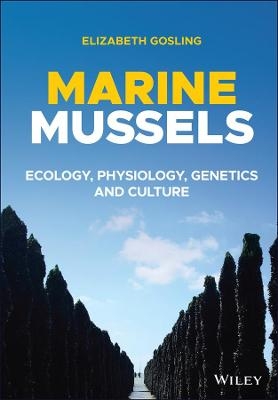
Marine Mussels
John Wiley & Sons Inc (Verlag)
978-1-119-29390-3 (ISBN)
Marine Mussels: Ecology, Physiology, Genetics and Culture provides readers with in-depth, fully up-to-date information on all major aspects of marine mussels. Written by an internationally renowned expert in the field, this authoritative volume addresses morphology, ecology, feeding, phylogeny and evolution, reproduction and larval development, settlement and recruitment, genetics, disease, management of culture systems and more. The book encompasses many different species of marine mussels: genus Mytilus, other important commercial marine genera such as Perna, Aulacomya and Choromytilus, and non-commercial genera including Modiolus, Geukensia, Brachidontes and hydrothermal vent Bathymodiolus.
Comprising twelve extensively cross-referenced chapters, the book discusses a diversity of integrated topics that range from fundamental physiology of marine mussels to new techniques being applied in their biology and ecology. Author Elizabeth Gosling reviews contemporary developments and issues in the field such as the use of DNA genetic markers in detecting and diagnosing different strains of pathogenic bacteria, the use of mussels as monitors of marine contaminants, sophisticated modelling techniques that simulate disease and forecast outbreaks, and the impacts of global warming, ocean acidification and hypoxia on marine mussels. Presenting an inclusive, highly detailed treatment of mussel biology, physiology, genetics, and culture, this invaluable resource:
Contains thorough descriptions of external and internal anatomy, global and local distribution patterns, the impacts of mussels on marine ecosystems, and the processes of circulation, respiration, excretion and osmoregulation
Reflects significant advances in mussel science and new areas of research in marine mussels
Describes the fundamentals of mussel aquaculture, the types and levels of contaminants in the marine environment and new approaches for sustainable aquaculture development
Discusses the application of genetic methods, population genetics, global breeding programmes and the emerging area of bivalve genomics
Addresses the role of mussels in disease transmission to humans, including production and processing controls, regulation of monitoring and quality control
Marine Mussels: Ecology, Physiology, Genetics and Culture is essential reading for biological scientists, researchers, instructors and advanced students in the fields of biology, ecology, aquaculture, environmental science, toxicology, genetics, pathology, taxonomy and public health.
Elizabeth Gosling, PhD, DSc, Galway-Mayo Institute of Technology, Ireland, is an author of international repute with a huge wealth of research, teaching and hands-on experience of working with bivalves, specifically marine mussels.
Preface ix
Acknowledgements xiii
1 Phylogeny and Evolution of Marine Mussels 1
Introduction 1
Phylogeny of the Phylum Mollusca 1
Phylogeny and Evolution of Bivalvia 3
Evolution and Adaptive Radiation in Bivalvia 5
Phylogeny and Evolution in the Mytilida 8
Significant Evolutionary Developments in the Family Mytilidae 11
Notes 15
References 16
2 Functional Morphology 21
Introduction 21
Shell 21
Mantle 29
Gills 31
Foot 34
Labial Palps 40
Alimentary Canal 40
Gonads 43
Heart and Haemolymph Vessels 43
Excretory Organs 44
Nerves and Sensory Receptors 45
References 47
3 Ecology of Marine Mussels 56
Introduction 56
Global and Local Distribution Patterns 57
Factors Affecting Geographic Distribution 64
Factors Affecting Local Distribution 69
Climate Change and Potential and Observed Impacts on Marine Mussels 102
Notes 116
References 116
4 Particle Processing and Nutrient Utilisation 141
Introduction 141
Filtration and Clearance Rates 141
Particle Processing on the Gills and Labial Palps and in the Stomach 157
Alimentary Canal and Digestive Process 174
Absorption Efficiency 191
Impacts of Mussels on Marine Ecosystems 194
Notes 198
References 199
5 Reproduction, Larval Development, Dispersal and Recruitment 219
Introduction 219
Sex Identification 219
Doubly Uniparental Inheritance and Sex Determination 221
Gametogenesis 222
Reproductive Cycles 225
Factors Controlling Reproduction 235
Reproductive Effort and Fecundity 242
Fertilisation and Gamete Compatibility 245
Larval Development 247
Factors Affecting Larval Growth 249
Larval Dispersal and Population Connectivity 253
Settlement, Metamorphosis and Post-Larval Dispersal 259
Recruitment 263
Notes 267
References 267
6 Growth 296
Introduction 296
Measurement of Absolute Growth 296
Measurement of Allometric Growth 307
Scope for Growth and Dynamic Energy Budget Models 311
Growth Modulators 317
Notes 338
References 338
7 Physiology of the Circulatory, Respiratory and Excretory Systems 357
Cardiovascular System 357
Respiratory System 365
Excretory System 388
Notes 400
References 400
8 Mussels and Marine Environmental Contaminants 414
Introduction 414
Contaminants in the Marine Environment 416
Contaminant Levels in Seawater, Sediments and Biota 444
Kinetic Modeling in Contaminant Bioaccumulation 448
Mussel Monitoring Programmes 460
Biological Markers of Pollution 471
Notes 486
References 487
9 Population Genetics, Genomics and Selective Breeding 515
Introduction 515
Population Genetics 516
Mussel Genomics 553
Quantitative
Genetics 567
Notes 578
References 579
10 Mussel Culture 603
Introduction 603
Wild Seed Collection 604
Hatchery Culture of Seed and Juvenile Mussels 605
Hatchery Culture of Mussels 615
Mussel Culture 630
Mussel Culture and the Environment 645
An Ecosystem Approach to Bivalve Culture 653
Notes 657
References 657
11 Diseases, Parasites and the Immune Response 675
Introduction 675
Viruses 675
Bacteria 677
Fungi 678
Protistans 682
Porifera 692
Platyhelminths 694
Annelids 703
Crustaceans 704
Neoplasia 711
Defence Mechanisms 714
Signal Transduction Pathways 725
Abiotic Effects on Mussel Immune Response 726
Notes 727
References 727
12 Mussels and Public Health 753
Introduction 753
Bacterial Infections 753
Viral Infections 759
Parasites 763
Biotoxins 766
Industrial Pollutants 779
Controls on the Production and Processing of Mussels and Other Bivalves 784
Monitoring and Quality Control 798
Hazard Analysis and Critical Control Point and its Application 800
Notes 805
References 805
Species Index 831
Subject Index 838
| Erscheinungsdatum | 27.04.2020 |
|---|---|
| Verlagsort | New York |
| Sprache | englisch |
| Maße | 170 x 244 mm |
| Gewicht | 1786 g |
| Themenwelt | Naturwissenschaften ► Biologie ► Zoologie |
| Weitere Fachgebiete ► Land- / Forstwirtschaft / Fischerei | |
| ISBN-10 | 1-119-29390-1 / 1119293901 |
| ISBN-13 | 978-1-119-29390-3 / 9781119293903 |
| Zustand | Neuware |
| Haben Sie eine Frage zum Produkt? |
aus dem Bereich


